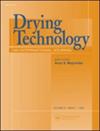真空管过滤器(VTF)系统处理砂粘土混合浆的脱水速率
IF 2.7
3区 工程技术
Q3 ENGINEERING, CHEMICAL
引用次数: 0
摘要
本文章由计算机程序翻译,如有差异,请以英文原文为准。
Dewatering rate of vacuum tube filter (VTF)-system-treated sand–clay mixed slurry
Abstract Vacuum dewatering methods are widely used to treat high-moisture dredged sludge; however, significant particle migration problems exist during treatment, particularly for sand–clay mixture slurries. A dewatering technology called a vacuum tube filter (VTF) system is proposed herein to alleviate the particle migration problem of sand–clay mixture slurries. First, four sets of model tests were performed using the VTF system and conventional vacuum (dewatering) method (CVM, i.e., a prefabricated strip-shaped drain assisted by vacuum) with two types of sand–clay mixed slurries. The water content distribution, settlement, and discharged water from the VTF system were compared with those from the CVM. The VTF system was superior to the CVM in terms of the dewatering rate and effect. Moreover, the particle migration problem was theoretically analyzed using a consolidation solution. With both slurries, the VTF system exhibited a lower particle-migration-problem-induced clogging effect. Thus, the VTF system can effectively alleviate the particle migration problem and enhance the dewatering of high-moisture sand–clay slurries.
求助全文
通过发布文献求助,成功后即可免费获取论文全文。
去求助
来源期刊

Drying Technology
工程技术-工程:化工
CiteScore
7.40
自引率
15.20%
发文量
133
审稿时长
2 months
期刊介绍:
Drying Technology explores the science and technology, and the engineering aspects of drying, dewatering, and related topics.
Articles in this multi-disciplinary journal cover the following themes:
-Fundamental and applied aspects of dryers in diverse industrial sectors-
Mathematical modeling of drying and dryers-
Computer modeling of transport processes in multi-phase systems-
Material science aspects of drying-
Transport phenomena in porous media-
Design, scale-up, control and off-design analysis of dryers-
Energy, environmental, safety and techno-economic aspects-
Quality parameters in drying operations-
Pre- and post-drying operations-
Novel drying technologies.
This peer-reviewed journal provides an archival reference for scientists, engineers, and technologists in all industrial sectors and academia concerned with any aspect of thermal or nonthermal dehydration and allied operations.
 求助内容:
求助内容: 应助结果提醒方式:
应助结果提醒方式:


